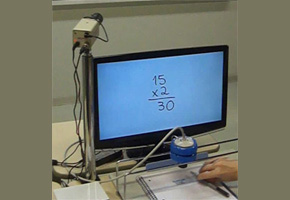

System allow students to see an enlarged version of what’s on the board and what they write in their notebooks (release)
System allow students to see an enlarged version of what’s on the board and what they write in their notebooks.
System allow students to see an enlarged version of what’s on the board and what they write in their notebooks.

System allow students to see an enlarged version of what’s on the board and what they write in their notebooks (release)
By Elton Alisson
Agência FAPESP – Bonavision, a company founded by a researcher at the Ophthalmology Clinic at Universidade de São Paulo’s Hospital das Clínicas, has developed a system for students with vision below 30%, or subnormal vision, to comfortably see what is on the board and what they write in their notebooks in an enlarged format inside the classroom.
The result of a project undertaken with funding from FAPESP programs such as Innovative Research in Small Companies and Support for Intellectual Property (PAPI), the equipment is ergonomic and costs half the price of imported products for the same purpose, affirms ophthalmologist José Américo Bonatti, one of the directors of the company.
“The price of imported equipment is around R$ 8,000, while the system we developed costs R$ 4,000 and is more ergonomic,” commented Bonatti.
According to Bonatti, the imported equipment comprises a video camera, which can be adjusted for close or long range, that is mounted in a fixed base with a flexible stem connected to a computer or TV monitor, similar to a webcam.
The user must adjust the video camera upward in the direction of the board to view the enlarged images via the equipment monitor placed on the desk. To see what he or she is writing, the camera must be turned downward at a 90o angle to focus on the notebook.
When shifting the camera’s focus from the board to the notebook and vice versa, however, the user often loses his or her place. “If the student forgets what was written on the board when writing with the camera focused on the notebook, she will have to focus on the board and look for the place where she left off before. This discourages learning,” ponders Bonatti.
In the past four years, the researcher and his partner, Fernanda Bonatti, who holds a PhD in design from USP’s architecture school, have studied ways to resolve this problem. The solution they reached was a system with two video cameras connected to the same monitor.
The first video camera is focused on the board and is mounted on a vertical base with a flexible stem that rests on the desk. The second video camera, which is adjusted for short-range projection, slides along a track on a slate, which the company developed at an earlier stage, to aid reading and writing.
To switch between the two cameras without losing the image of the board or the notebook, the researchers developed a control button that can be used at will.
“With the control button, the student can alternate the use of the two video cameras on the same screen. When the user is writing and forgets what was on the board, she can just push a button and the exact image of what was being copied will appear on the screen. By pushing the button again, the image of the notebook will pop back on screen and vice versa,” explained Bonatti.
Inclusive System
The company began selling the equipment at the beginning of this year via its website. In addition to allowing switching between the cameras and enlarging the image by 15 times, the new equipment has the advantages of ease of use and the inclusion of visually impaired students, eliminating the need for human aides in classrooms to assist with reading what’s on the board.
“There are cases where teachers of students with visual impairments have to stand beside the student to read whatever is written on the board and cases where students who have to stand very close to the board to see what is written and then return to their desks to copy it,” explained Bonatti. “These two situations are extremely tiresome,” he adds.
The new product is the company’s fourth launch. The first, released in 2008, is a special magnifying glass for reading that enlarges text by sevenfold. In 2009, the company’s researchers launched a reading slate with a magnifying glass. In 2011, they developed an electronic version of the slate, which served as the basis for the alternating cameras.
Like other equipment, the system was developed to be used with minimal training, noted Bonatti. “We attempted to develop a simple system that allows the user to memorize what is on the board line by line or as larger amounts of text, depending on memorization capacity, and it is easy to use. We took a longer time to develop a simple solution than to develop the technology itself,” said Bonatti.
The researcher gave a presentation on his experience with the development of reading aids for visually impaired patients on August 14, during the 5th Week of Intellectual Property & Innovation, sponsored by USP’s Innovation Agency.
Republish
The Agency FAPESP licenses news via Creative Commons (CC-BY-NC-ND) so that they can be republished free of charge and in a simple way by other digital or printed vehicles. Agência FAPESP must be credited as the source of the content being republished and the name of the reporter (if any) must be attributed. Using the HMTL button below allows compliance with these rules, detailed in Digital Republishing Policy FAPESP.




